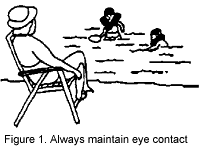Farm ponds, lagoons, and water wells are popular on Pennsylvania farms but all have contributed to accidental drownings. Most victims range in age from toddlers to young adults, and do not reside on the property or site.
Children, under the age of four, make up the largest group that drown in ponds. Some get too close to the water's edge and lose their balance in the soft earth. Others wade in shallow water and fall into deeper holes. No one knows what happens in other cases. However, lack of close supervision, underestimating a child's curiosity, and adults overestimating a child's sense of judgment all contribute to pond drownings.
 Even though a child verbally acknowledges a warning or caution,
it does not mean that he/she understands the hazard or risk,
or will behave appropriately. The short attention span of
a child, plus the attractiveness of the water as a play area,
render most verbal instructions ineffective. An adult supervisor
should never lose eye contact with a child playing near a
pond or lagoon (see Figure 1). Teaching a child to swim at
the earliest possible age helps eliminate this problem.
Even though a child verbally acknowledges a warning or caution,
it does not mean that he/she understands the hazard or risk,
or will behave appropriately. The short attention span of
a child, plus the attractiveness of the water as a play area,
render most verbal instructions ineffective. An adult supervisor
should never lose eye contact with a child playing near a
pond or lagoon (see Figure 1). Teaching a child to swim at
the earliest possible age helps eliminate this problem.
Adults, too, drown in farm ponds. Data indicate accidents occur when people use these areas for recreational swimming. Most victims were in their late teens or early twenties and visitors to the area. Sharp drop-offs on the pond floor and leg cramps may cause even experienced swimmers to have problems. Multiple drownings have occurred when one person tried to rescue another.
There are other dangers associated with farm ponds. Some may be contaminated by fertilizer and pesticide runoff, livestock waste, or other pollutants. If water is cloudy, has a foul odor, or is littered with algae, it should not be used for swimming, due to possible infectious agents. Ponds used for swimming should be analyzed every spring for water quality by a qualified laboratory. Other dangers lurk beneath a farm pond's surface. Jagged rocks, broken bottles, animal bones, and other miscellaneous junk are common in farm ponds.
In general, it is recommended that all ponds (and lagoons) be fenced and posted to keep uninvited persons out. Non-posted, non-fenced ponds increase the risk of a court suit if uninvited swimmers drown. Restrict entrance to your pond. This will help keep out uninvited guests.
To make your farm pond safe for you and others to swim, try to eliminate all physical hazards. This may mean grading a bank for easy entrance, dragging shallow areas for dangerous objects, marking drop-offs, or roping off unsafe areas. Use depth markers and signs so everyone can see how deep the pond is at different spots.
 Every farm pond used for swimming should have a rescue post
(see Figure 2). It should be placed firmly in the ground near
the water and painted yellow. Obtain a nylon rope long enough
to reach across the pond. Attach one end of the rope to a
life ring, the other end to a wood block, and hang all these
on the post. A one gallon, plastic milk jug containing one
pint of water could also serve as your buoy. A thin 12 to
14 foot pole should also be kept at the rescue post as an
aid in helping someone out. Finally, the location of the nearest
telephone and emergency numbers should be painted on a sign
and attached to the post.
Every farm pond used for swimming should have a rescue post
(see Figure 2). It should be placed firmly in the ground near
the water and painted yellow. Obtain a nylon rope long enough
to reach across the pond. Attach one end of the rope to a
life ring, the other end to a wood block, and hang all these
on the post. A one gallon, plastic milk jug containing one
pint of water could also serve as your buoy. A thin 12 to
14 foot pole should also be kept at the rescue post as an
aid in helping someone out. Finally, the location of the nearest
telephone and emergency numbers should be painted on a sign
and attached to the post.
One person should never swim alone, even if he/she is an expert swimmer. Those who swim in farm ponds should also be familiar with drown-proofing and artificial respiration techniques. These are taught by the American Red Cross and other swimming instruction programs.
Other drownings are caused by falling into wells, particularly those no longer in use. Most wells, when abandoned, were closed by planks or other covering devices. But planks rot over the years and covers get removed for a variety of reasons. Sometimes older children or pranksters will open up wells, not realizing the seriousness of their actions. Old wells should have solid covers which can't be easily removed, they should be checked regularly. It might be possible to fence off the well area to keep children away. Better yet, fill in old wells to completely remove the hazard.
Publication #: 27
This document was
published in 1990 as Pennsylvania State University Fact Sheet
Safety, Pennsylvania
Cooperative Extension Service. For more information, contact
Pennsylvania State University College of Agricultural Sciences,
Agricultural Engineering Department, 246 Agricultural Engineering
Building, University Park, PA 16802.
Dennis J. Murphy, professor, Agricultural Engineering Department,
Cooperative Extension Service, Pennsylvania State University,
University Park, PA 16802.
Disclaimer and Reproduction Information: Information in NASD does not represent NIOSH policy. Information included in NASD appears by permission of the author and/or copyright holder. More